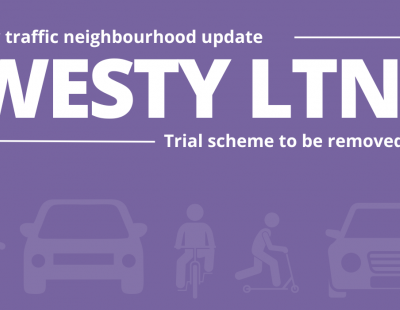The trial LTN has been in place since June 2022. It was introduced in response to concerns raised by local residents, through the Central 6 Regeneration Masterplan consultation – along with consultation undertaken in Westy in late 2021 - around traffic levels, road safety, air pollution and the quality of streets.
Aimed at cutting down on the number of cars moving through residential streets in Westy, reducing air and noise pollution and increasing safety for pedestrians and cyclists, the LTN was put in place on a trial basis, to enable the council to gather evidence and data and listen to public feedback.
Throughout the trial, the council has engaged with local people through a range of channels, including surveys and letter drops and has now been able to produce an initial report on the impact of the scheme and the results of the recent consultation which took place over one month from late April until late May 2023.
While the data shows that the LTN has largely had the impact it was meant to have, it has not been popular with many residents, with the large majority of people who took part in the consultation saying that they want it to be removed.
Therefore, the council will proceed with the removal of the LTN, with the temporary wooden planters to be taken away in the near future.
Warrington Borough Council’s Cabinet Member for transportation, highways and public realm, Cllr Hans Mundry, said: “We know how vital it is for us to do everything we can to tackle the climate emergency we are all facing. That means we are going to have to make some tough decisions to reduce the number of cars on our roads. Our priority has to be cutting emissions, improving air quality and supporting better bus and rail services, safer cycling and walking.
“Rapid change is required, which is why we need to try out new and innovative initiatives. During the Central 6 Masterplan consultation, local people told us that there was too much traffic, going too quickly, along residential streets in the area. After a lot of detailed thought, we identified an LTN – an initiative supported, promoted and actively funded by the government – as a tactic we could use to effectively address these issues.
“We knew that there were a number of cases of where these types of scheme have worked – particularly in areas of London. Indeed, the data and evidence we have collected during the Westy LTN trial period shows that the scheme has had many of the desired outcomes.
“However, we also know that schemes which aim to change common travel habits can be unpopular and can ultimately inconvenience some people. That’s why, from the outset, we pledged to fully take on board all feedback from the public. We listened to local people’s views and acted on them, including making several changes to the LTN scheme last October. We have continued to listen, and it is the views of local people which have, ultimately, played a central role in our decisions not to keep the LTN in place.
“While the fundamental purpose of LTNs is to create a cleaner, greener and safer environment, there has been much controversy and debate over their implementation, nationally, in recent months. The strong opposition against the Westy LTN is something that we have seen reflected in other LTN schemes in different parts of the country. This strength of feeling in Warrington has been a key factor in our decision to remove the scheme.
“Our LTN was always an experiment, and while it is not, in the end, a scheme we will be moving forward with, I believe it was the right decision to trial it, as part of the vital, ongoing work we are doing to improve the quality of our neighbourhoods.
“With government funding now withdrawn for new LTN schemes, it’s about looking to the future and identifying new ways of cutting the number of cars on our roads, reducing air pollution and protecting the health of our people and our planet. This work will continue and will need to be shaped by national guidance, policy and legislation.”
